
The problem
Across Europe, including in the UK, we see the following:
- Daily ‘cases’ sky-rocketed in Europe as Autumn arrived.
- Daily deaths labelled as ‘Covid deaths’ rose in line with ‘cases’ – to levels apparently higher than at the Spring peak.
- BUT: Total all-cause mortality does not reflect the above.
What is behind this conundrum?
The central thesis of this paper is that we have a major problem with PCR-testing.
This is distorting policy and creating the illusion that we are in a serious pandemic when in fact we are not.
This is causing:
- Excess deaths due to restricted access to the NHS.
- An NHS staffing crisis which is exacerbating matters.
- Unprecedented assaults on civil liberties and the economy.
What we need to do about this:
- Stop mass-testing using PCR in the UK and replace with Lateral Flow Tests where required.
- Other recommendations as detailed later in this document.
It should be noted that legal cases and technical challenges to PCR mass-testing are growing across Europe, including in the UK.
NB: The info contained in this paper is merely illustrative of some of the key issues and does not represent the totality of the evidence available.
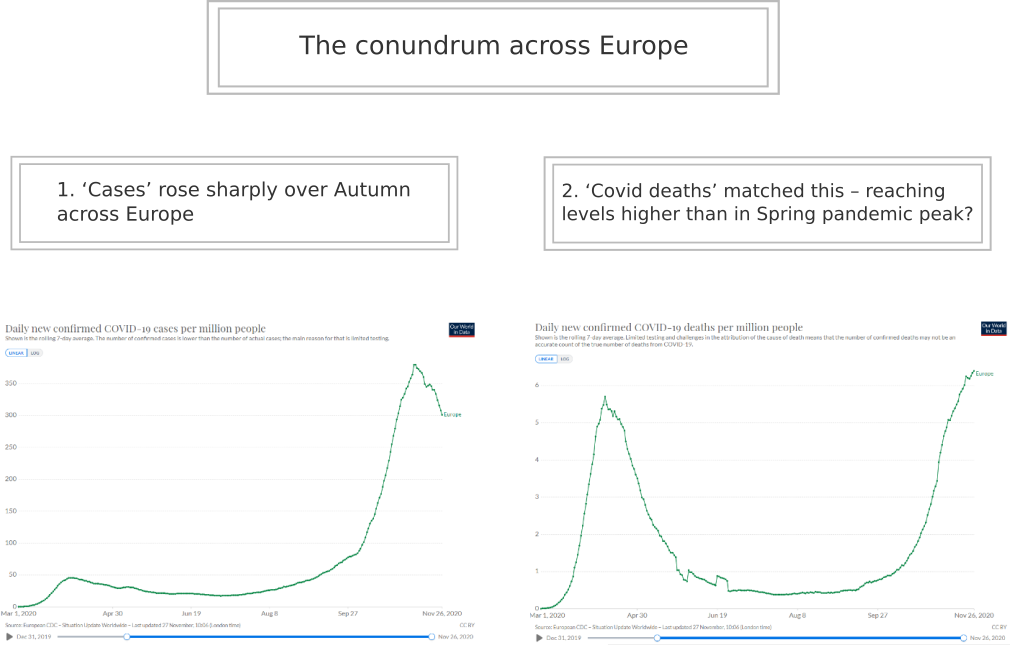
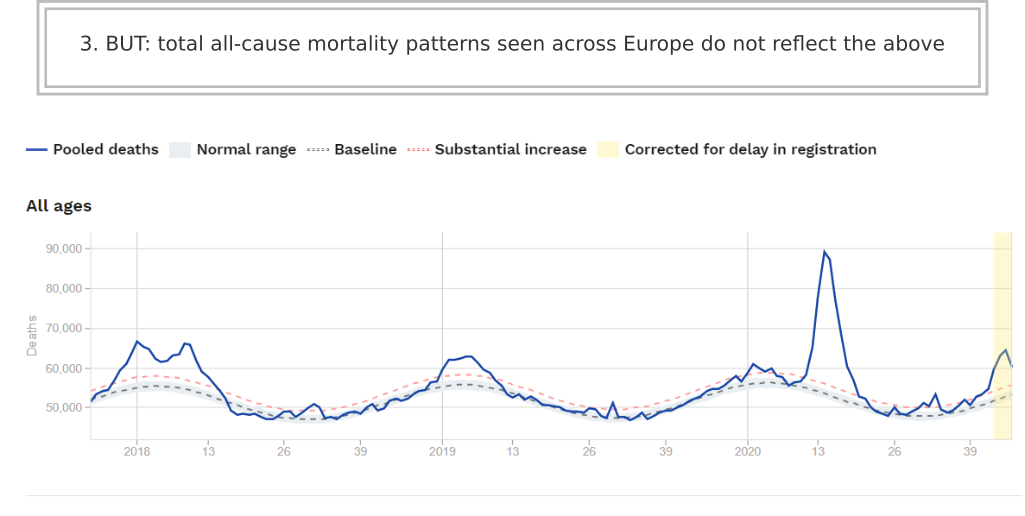
The current problem is that both Covid cases and Covid deaths are being overstated massively due to confused definitions and poor measurements. Claims of Covid deaths should be backed up with evidence that they were really caused by Covid. From the data, it seems reasonable to assume that at least 10% were not caused by Covid. They have been misdiagnosed due to faulty testing – we explain our reasoning below, point 5 being the most important. Misdiagnosis has resulted from false positive laboratory tests.
An epidemic is defined as the wide spread of an infectious disease. The final letter of Covid is ‘D’ for ‘disease’. A disease requires symptoms. Public Health England’s National COVID-19 case definition required the presence of symptoms. Somehow symptoms have become irrelevant. We are now chasing down the healthy, immune population who are being over-tested. This includes those in hospital with other symptoms and for other reasons. If we tested for influenza in the same way and with the same implications, we would have to lock down every winter.
A false positive pseudo-epidemic is a well described phenomenon in the medical literature which results in an exponential rise in diagnosed cases and deaths but no excess deaths. PCR testing is renowned for it and the “second wave” of Swine Flu in 2009 was entirely a false positive pseudo-epidemic only stopped by stopping the testing. SAGE have been focused on the constant low false positive rate of the testing equipment but the false positive rate of the whole testing process is variable and can rise.
Evidence of one laboratory with a low operational false positive rate gives no indication of what the operational false positive rate is in a different laboratory or at a different point in time.
A good lay description of a false positive pseudo-epidemic can be found here.
Fundamental flaws of the current UK approach
1) The definition of Covid deaths is too broad. Currently any death with an incidental positive Covid test within prior 28 days is counted as Covid. However, even deaths from the misdiagnosis of respiratory failure will result in Covid being put as the primary cause. There is no post mortem evidence that these are Covid deaths. There is no equivalent rise in death certificates with mentions of pneumonia as was seen in the spring. Accident and Emergency attendances for acute respiratory infections are currently 300 per day lower than average.

2) The tests are not measuring the disease. It is nonsense to rely simply on positive test cases without requiring the presence of symptoms to define the scale of the epidemic. However, if positive tests are to be used, determination of the test accuracy rate is absolutely essential (especially the false positive rate). These should be independently determined. This work must be current to assess the current rates. Those defending the tests claim they have been quality checked by the use of “whole genome sequencing” – but that test has never been used as a diagnostic test in this way either, so it’s like using one unvalidated process to validate another.
(The final page of this briefing provides some more background on why even an apparently low FPR can be so misleading.)
Symptom trackers, NHS triage data and GP consultation data all show that patients attending with Covid like conditions back to background levels; yet positive test results continued to rise during this time. This strongly implies that the test results are picking up largely false positives.
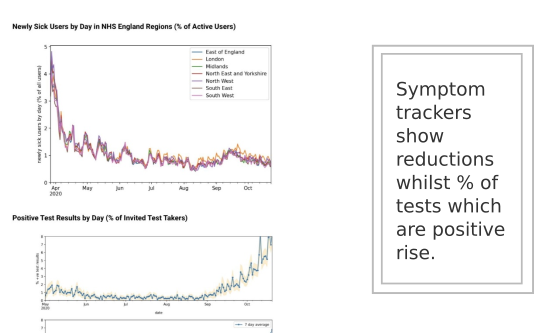
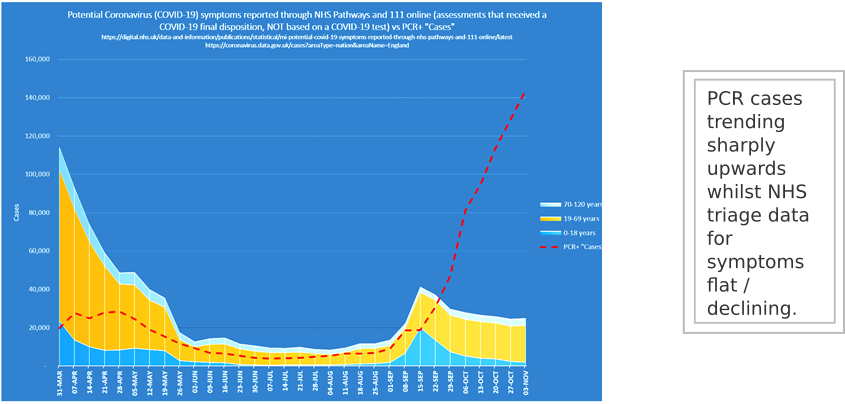
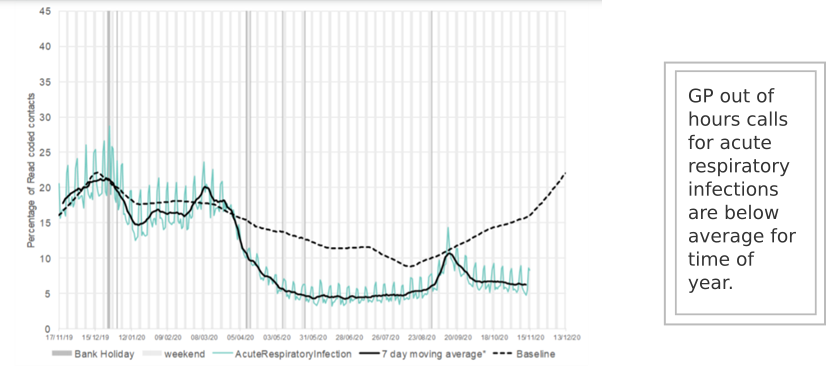
3) Excess deaths are not all Covid deaths. Pandemics can cause excess deaths. Lockdowns can also cause excess deaths and we saw excess deaths from many causes in Spring. There appears to have been no attempt to analyse these deaths or factor them into current decision-making processes. Normal interactions with the health service have still not resumed and excess deaths in the 15-44 year-old age group have climbed steadily throughout the year. These are nearly all non-Covid deaths.

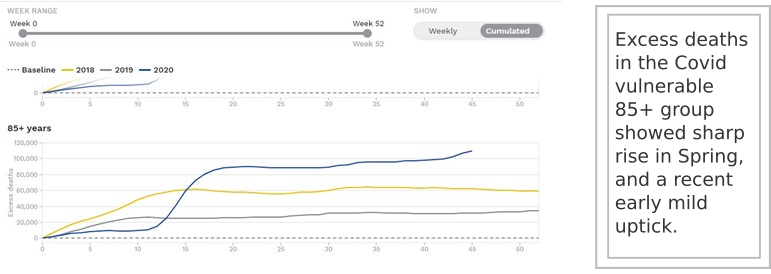
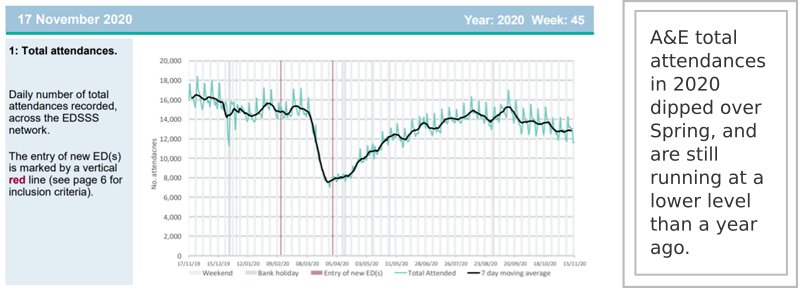
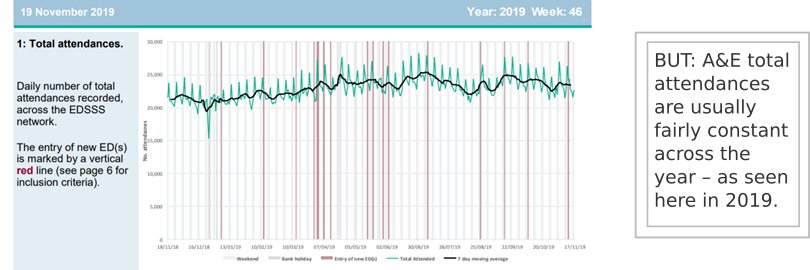
4) There is an NHS staffing crisis caused by false positive test results. NHS including ambulance staff and care home staff are all being tested and made to isolate merely on the basis of a single positive test even when asymptomatic, when the evidence on spread from asymptomatic subjects is equivocal at best. This is causing a staffing crisis in the NHS which will undoubtedly result in patients dying.
5) The only confirmatory testing carried out has shown no Covid. Army testing in Liverpool uses a different and more reliable test – the ‘Lateral Flow Test’ (LFT). It has demonstrated that there is minimal Covid in the Liverpool community, the alleged hotspot. The numbers testing positive are barely above the false positive rate reported for the LFT meaning there were no real Covid cases found. In other words, the Army results confirm the fact that at least 90% of the PCR were false positives and the government is panicking on the basis of a massively exaggerated and unreliable statistic.
Numerous well-conducted studies have demonstrated that LFT tests have a sensitivity of about 80% (ie they identify 4 out of 5 ‘true’ cases). LFT tests are particularly good at identifying patients during the infective period and that is after all what testing is attempting to achieve. However, when contradictions are seen between LFT and PCR results, many people rush to the accusation that LFT testing are missing cases. In fact, LFT testing is highlighting the failings of PCR testing. An 80% sensitivity rate means not every case is found, but it is actually the same sensitivity rate as seen with PCR testing.
6) Weak criteria used to declare a positive will result in false positives. Testing in May, by Imperial College showed that only half of the positive results from commercial laboratories were true positives and they questioned the criteria these laboratories were using to define a positive.
7) The results from PCR testing no longer fit reality.
ONS random population sampling, using PCR testing, predicted that 4300 in 100,000 of the population of Salford (4.3%) had COVID on 11th November (16 times higher than their national estimate for 27th April to 10th May). Typically, during a pandemic, the general prevalence in the entire population is substantially less than 1%.
Finally, positivity rates from PCR testing started to become strongly correlated with the volume of testing carried out after the middle of July.
The below graph shows the data for London aggregated. But the pattern is the same for all boroughs in London. After mid-July, the best indicator of whether a test would be positive was the volume of testing carried out – not where the person lives.
This cannot be to do with biology and is entirely artefactual. Readers might well ask – what happened in mid-July?
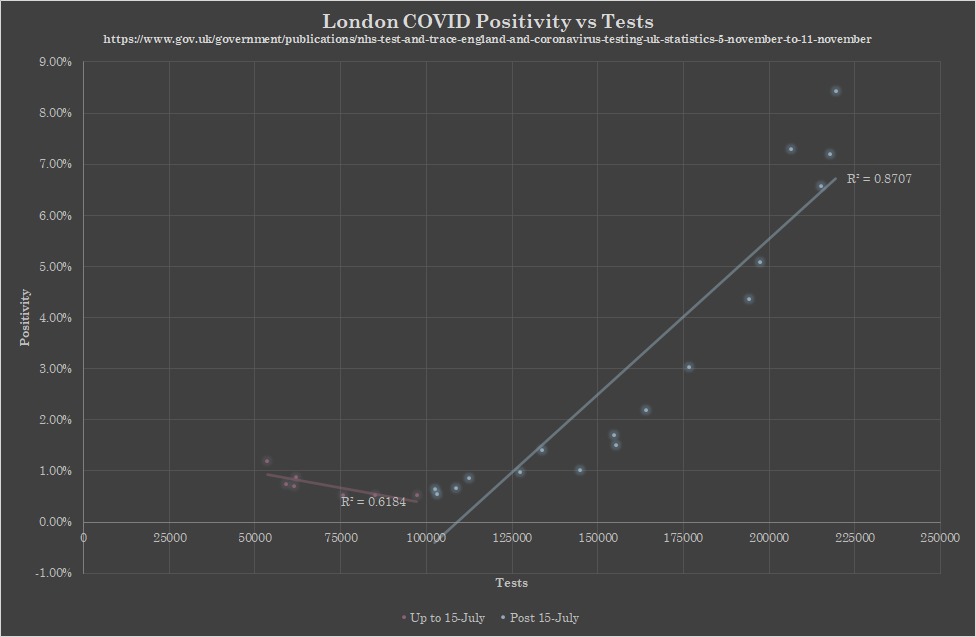
The answer is that from that date, the volume of Pillar 2 (community) testing was ramped up hugely whilst the volume of Pillar 1 (in hospital / PHE) testing remained constant.
Pillar 2 testing – conducted by private labs at high volume – involves the use of DIY kits, self-sampling, collections in car parks, samples sent by post and car park collections, creating huge potential for contamination issues and other operational problems.
This is incontrovertible proof that the rise in cases is purely as a result of problems with testing. The data is currently being analysed for the rest of England and is consistent with London.
The PCR-based system routinely reports positivity values exceeding the absurd, and these are accepted without comment. This has been allowed to happen because the assumption is that PCR is high science and cannot be far wrong. Nothing can be further from the truth.
Recommended actions
The following are the most important actions to be taken immediately:
- Stop mass testing asymptomatic individuals. The entire basis for mass testing the population is based on the flawed and questionable assumption that transmission of infection from those with no symptoms is an important contribution to epidemic spread. Regardless of arguments about this, it is clear we are no longer in an epidemic and therefore there is no justification for mass testing, no matter the method involved.
- Re-test a sample of hospitalised patients previously diagnosed (by PCR alone) using Lateral Flow Tests. Even if LFT misses some cases, the majority should still test positive. If the numbers testing positive are low, this confirms we have a problem with the PCR test.
- If PCR is to continue to be used at all, it should be at low scale and on no account should this involve the high capacity facilities known as Lighthouse Labs. The stretch for capacity is wholly responsible for the PCR false positive pseudo epidemic. It is the view of those with the greatest hands-on experience of PCR that such facilities cannot yield results of the precision now required.
- Even conducted at lower scale, it is vital that additional quality control measures for PCR testing are instituted, including (but not limited to) running ‘end to end’ negative controls containing other viruses and other human DNA through the entire test system, in order to quantify any false positive results due to laboratory issues (akin to ‘secret shopper’ checking). Additionally, PCR testing must revert to high stringency, with a requirement for all three genes to be positive – as used in Spring.
- Hospital/NHS and care-home staff absence policies should be based primarily on LFT testing, using PCR testing for confirmation of positive tests only.
- The definition of ‘an outbreak’ must require subjects to have positive LFT results with confirmatory testing using high-quality PCR tests conducted in a well-managed laboratory, combined with symptoms and evidence of direct contact.
- Overturn the Ofcom ban on free speech in broadcast media. Earlier in 2020 OFCOM issued a series of innocent sounding Notes to Broadcasters in relation to reporting on coronavirus matters. These require broadcasters to adhere to certain lines consistent with Government policy and these have had the effect of suppressing much by way of alternative viewpoints. As we are no longer in a public health emergency, the justification for quashing alternative scientific voices has gone and only by hearing all views can a valid scientific consensus be reached.
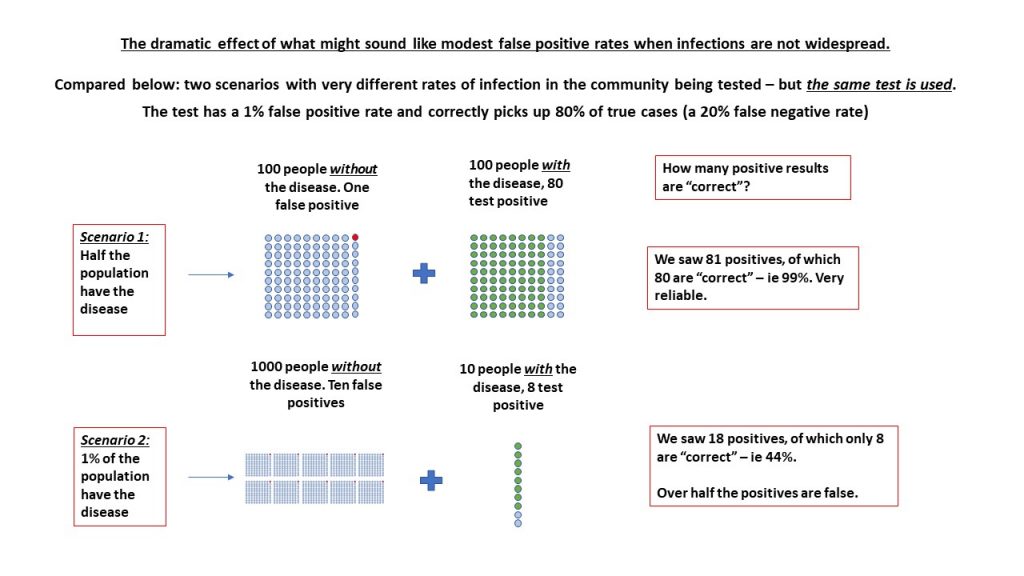
Appendix – why low False Positive Rates can still be problematic
So what is the Operational FPR for Covid testing?
The Government has not published it and has admitted it does not know what it is, hence it’s not possible to say what fraction of the tests are genuine. All of them? Half of them? None of them? Any reasonable person would regard it as an affront to permit continued deployment of this test.
It would be negligent for a physician to perform a diagnostic test for their patient without knowing what the results meant, yet by their own admission, the Government does not know what their results mean. It’s tendentious to claim that an operational FPR obtained in a different test (not even the same test) can be adopted. It cannot. This yawning gap must be closed & meanwhile the test discontinued.
In a SAGE paper from June, it was stated that for other RNA viruses the OFPR ranged from 0.8 to 4.0%. For Covid testing, a figure of less than 1% has been suggested. We know that the quality of the testing lab can dramatically affect the FPR, and we know that there have been significant quality issues as volumes were ramped up at a faster speed than has ever been done before. So, 1% is most likely a significant under-estimate of the current situation.
As for how many people have it, the ONS say it is currently around 1.2% – but this is simply not credible, when in late April / early May they claimed that only 0.27% had it, and the Liverpool mass testing found only 0.6% (around the same as the operational FPR for the ‘Lateral Flow Test’ which would mean there was no Covid in Liverpool).
Using a figure of 2% for FPR, a 20% false negative rate, and incidence in the population of 0.5%, around 83% of all positive tests results would be misdiagnoses.
This document has been authored by:
- Clare Craig BM BCh FRCPath (craig.clare@gmail.com)
- Jonathan Engler MBChB LLB (jengler@outlook.com)
- Mike Yeadon BSc Hons (Biochem-tox) PhD (Pharmacol) (yeadon_m@yahoo.co.uk)
- Christian McNeill LL.B and Dip LP (christian.mcneill@icloud.com)
MPs are invited to contact any of the above if they have further questions, for example the source of any data quoted.
To download this briefing as a PDF to send to someone please click here.












Donate
We depend on your donations to keep this site going. Please give what you can.
Donate TodayComment on this Article
You’ll need to set up an account to comment if you don’t already have one. We ask for a minimum donation of £5 if you'd like to make a comment or post in our Forums.
Sign UpLatest News
Next PostLatest News